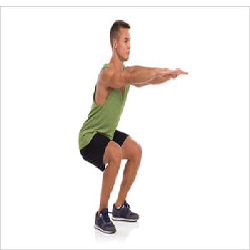
Anterior cruciate ligament strain and tensile forces for weight-bearing and non-weight-bearing exercises: a guide to exercise selection.
J Orthop Sports Phys Ther. 2012 Mar;42(3):208-20. doi: 10.2519/jospt.2012.3768. Epub 2012 Feb 29.
Escamilla RF1, Macleod TD et all
What we conclude from the study?
While examining ACL loading and the potential for the surrounding musculature to load or unload the ACL, the quadriceps and hamstrings are the primary muscles involved. Contraction of the quadriceps exerts an anteriorly directed force on the proximal tibia when the knee is flexed between 0-60 degrees which increases ACL loading. In knee flexion positions greater than 60 degrees the quadriceps exerts a posteriorly directed force unloading the ACL. The antagonist to the quadriceps is the hamstrings. When contracted the hamstrings exerts a posteriorly directed force on the proximal tibia throughout the entire knee range of motion. This helps to unload the ACL.
While most ACL rehabilitation protocols incorporate both weight-bearing (WB) and non-weight-bearing (NWB) exercises, there is evidence to suggest that individuals who perform predominantly WB exercises tend to have less knee pain and more stability.
One of the first exercises typically implemented towards the beginning of ACL rehabilitation is quad sets. A progression of this exercise is to place an ankle weight on the patient’s ankle to provide increased resistance upon VMO contraction, making the task more difficult.
However, the tensile force on the newly reconstructed ACL is almost two times greater when the resistive force is placed near the ankle as compared to the middle of the lower leg. As soon as a patient is able to fully bear weight on a reconstructed knee, close-chained exercises are recommended to allow strengthening of the surrounding musculature without increased tensile forces placed on the ACL.
For example, performing a double-leg mini-squat does not seem to produce an increase in ACL strain compared to a seated knee extension while in a knee-flexed position. The WB squat may actually help to recruit hamstring musculature to a greater extent which may potentially unload the ACL.
The primary factor associated with increased ACL strain with WB exercises is trunk positioning. Squatting with excessive forward movement of the knees beyond the toes and with the heels off the ground tends to increase ACL loading. Squatting and lunging with a forward trunk tilt tend to decrease ACL loading, likely due to increased hamstrings activity.
Therefore,maintaining a vertical trunk position during WB exercises moves the center of mass posteriorly. This causes the knees to move anteriorly over the toes to maintain balance, increasing ACL strain. Therefore, while in a WB position, a slightly forward trunk lean acts to decrease ACL loading by increasing hamstring activity.
Clinical Application
ACL loading is less with WB exercises compared to NWB exercises and ACL loading is relatively low with WB exercises performed in lower angles of knee flexion, early after surgery a rehabilitation protocol implementing more WB exercises may be more beneficial to a patient long term than a protocol implementing both WB and NWB exercises throughout the process.
Interestingly, performing seated knee extension (quadriceps activation only) with no external resistance produced the same amount of ACL strain as that produced by performing a single-leg sit-to-stand movement or stair climbing, with the WB exercises being much more challenging in recruiting hip and thigh musculature (quadriceps, hamstrings, and hip extensors, abductors, and external rotators), which helps stabilize the knee and protect the ACL.
However, NWB exercises can also be effective when employed correctly and at the correct time, and are often selected for their ability to isolate training of individual muscles, such as the quadriceps.
There is evidence to suggest that individuals who predominantly perform WB exercises, compared to NWB exercises, in their rehabilitation tend to have less knee pain and more stable knees, are generally more satisfied with the results, and go back to their sports sooner.
Image coursey : www.expertlifescience.com


